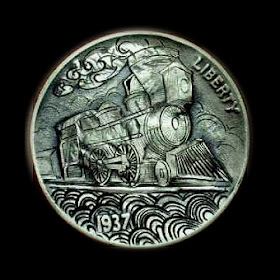Pages
▼
Thursday, 2 February 2012
Brother can you spare a dime (part 2)
Hobo nickels…
The altering of coins dates to the 18th century or earlier. Beginning in the 1750s, the most common form of coin alteration was the "potty coin", engraved on United States Seated Liberty coinage (half dime through trade dollar). This time period was also the heyday of the love token, which was made by machine-smoothing a coin (usually silver) on one or both sides, then engraving it with initials, monograms, names, scenes, etc., often with an ornate border. Hundreds of thousands of coins were altered in this manner. They were often mounted on pins or incorporated into bracelets and necklaces. The love token fad faded out in the early 20th century; love tokens engraved on buffalo nickels are rare.
Many artists made hobo nickels in the 1910s and 1920s, with new artists joining in as the years went by. The 1930s saw many talented artists adopting the medium. Bertram Wiegand, known almost exclusively as Bert, began carving nickels in the teens, and his student George Washington Hughes, known as Bo, began carving in the late teens (and up to 1980). During this period, Buffalo nickels were the most common nickels in circulation.















great! Folk art at its best!
ReplyDeleteYES I LIKE TOO!
ReplyDeleteWhat are the names of the artist represented?
ReplyDelete